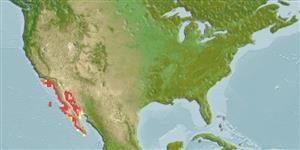Environment: milieu / climate zone / depth range / distribution range
Ökologie
seewasser demersal; tiefenbereich ? - 46 m (Ref. 2850), usually 3 - 15 m (Ref. 2850). Subtropical; 34°N - 20°N, 121°W - 109°W
Eastern Pacific: California, USA to Baja California, Mexico.
Length at first maturity / Size / Gewicht / Alter
Maturity: Lm ?, range 27 - ? cm
Max length : 45.0 cm TL Männchen/unbestimmt; (Ref. 9118); common length : 30.0 cm TL Männchen/unbestimmt; (Ref. 9118); max. veröff. Gewicht: 700.00 g (Ref. 2850); max. veröff. Alter: 20 Jahre (Ref. 72462)
Common species found near the bottom, often in caves and crevices of exposed coasts and open bays (Ref. 9118). Feeds on crabs (Ref. 9118).
Eschmeyer, W.N., E.S. Herald and H. Hammann, 1983. A field guide to Pacific coast fishes of North America. Boston (MA, USA): Houghton Mifflin Company. xii+336 p. (Ref. 2850)
IUCN Rote Liste Status (Ref. 130435)
Bedrohung für Menschen
Harmless
Nutzung durch Menschen
Tools
Zusatzinformationen
Download XML
Internet Quellen
Estimates based on models
Preferred temperature (Ref.
123201): 16.7 - 24.2, mean 22.3 °C (based on 110 cells).
Phylogenetic diversity index (Ref.
82804): PD
50 = 0.7500 [Uniqueness, from 0.5 = low to 2.0 = high].
Bayesian length-weight: a=0.00933 (0.00538 - 0.01619), b=3.09 (2.94 - 3.24), in cm total length, based on LWR estimates for this species & (Sub)family-body (Ref.
93245).
Trophic level (Ref.
69278): 3.6 ±0.60 se; based on food items.
Generation time: 6.0 ( na - na) years. Estimated as median ln(3)/K based on 1
growth studies.
Widerstandsfähigkeit (Ref.
120179): mittel, Verdopplung der Population dauert 1,4 - 4,4 Jahre. (K=0.18).
Fishing Vulnerability (Ref.
59153): Moderate to high vulnerability (49 of 100).
